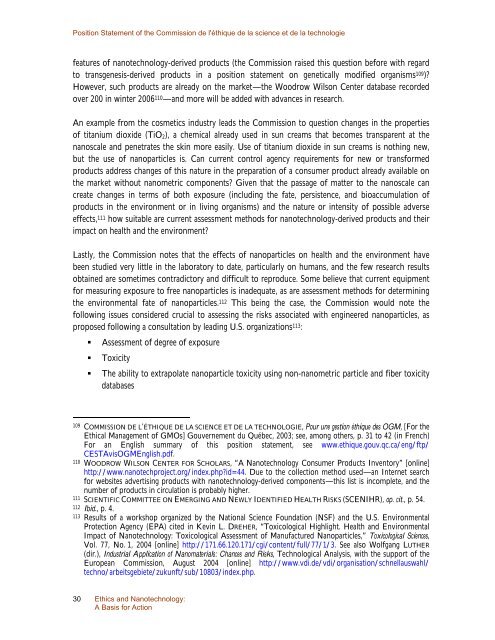A Basis for Action - Commission de l'éthique de la science et de la ...
A Basis for Action - Commission de l'éthique de la science et de la ...
A Basis for Action - Commission de l'éthique de la science et de la ...
Create successful ePaper yourself
Turn your PDF publications into a flip-book with our unique Google optimized e-Paper software.
Position Statement of the <strong>Commission</strong> <strong>de</strong> l'éthique <strong>de</strong> <strong>la</strong> <strong>science</strong> <strong>et</strong> <strong>de</strong> <strong>la</strong> technologie<br />
features of nanotechnology-<strong>de</strong>rived products (the <strong>Commission</strong> raised this question be<strong>for</strong>e with regard<br />
to transgenesis-<strong>de</strong>rived products in a position statement on gen<strong>et</strong>ically modified organisms 109 )?<br />
However, such products are already on the mark<strong>et</strong>—the Woodrow Wilson Center database recor<strong>de</strong>d<br />
over 200 in winter 2006 110 —and more will be ad<strong>de</strong>d with advances in research.<br />
An example from the cosm<strong>et</strong>ics industry leads the <strong>Commission</strong> to question changes in the properties<br />
of titanium dioxi<strong>de</strong> (TiO 2 ), a chemical already used in sun creams that becomes transparent at the<br />
nanoscale and pen<strong>et</strong>rates the skin more easily. Use of titanium dioxi<strong>de</strong> in sun creams is nothing new,<br />
but the use of nanoparticles is. Can current control agency requirements <strong>for</strong> new or trans<strong>for</strong>med<br />
products address changes of this nature in the preparation of a consumer product already avai<strong>la</strong>ble on<br />
the mark<strong>et</strong> without nanom<strong>et</strong>ric components? Given that the passage of matter to the nanoscale can<br />
create changes in terms of both exposure (including the fate, persistence, and bioaccumu<strong>la</strong>tion of<br />
products in the environment or in living organisms) and the nature or intensity of possible adverse<br />
effects, 111 how suitable are current assessment m<strong>et</strong>hods <strong>for</strong> nanotechnology-<strong>de</strong>rived products and their<br />
impact on health and the environment?<br />
Lastly, the <strong>Commission</strong> notes that the effects of nanoparticles on health and the environment have<br />
been studied very little in the <strong>la</strong>boratory to date, particu<strong>la</strong>rly on humans, and the few research results<br />
obtained are som<strong>et</strong>imes contradictory and difficult to reproduce. Some believe that current equipment<br />
<strong>for</strong> measuring exposure to free nanoparticles is ina<strong>de</strong>quate, as are assessment m<strong>et</strong>hods <strong>for</strong> <strong>de</strong>termining<br />
the environmental fate of nanoparticles. 112 This being the case, the <strong>Commission</strong> would note the<br />
following issues consi<strong>de</strong>red crucial to assessing the risks associated with engineered nanoparticles, as<br />
proposed following a consultation by leading U.S. organizations 113 :<br />
• Assessment of <strong>de</strong>gree of exposure<br />
• Toxicity<br />
• The ability to extrapo<strong>la</strong>te nanoparticle toxicity using non-nanom<strong>et</strong>ric particle and fiber toxicity<br />
databases<br />
109 COMMISSION DE L’ÉTHIQUE DE LA SCIENCE ET DE LA TECHNOLOGIE, Pour une gestion éthique <strong>de</strong>s OGM, [For the<br />
Ethical Management of GMOs] Gouvernement du Québec, 2003; see, among others, p. 31 to 42 (in French)<br />
For an English summary of this position statement, see www.<strong>et</strong>hique.gouv.qc.ca/eng/ftp/<br />
CESTAvisOGMEnglish.pdf.<br />
110 WOODROW WILSON CENTER FOR SCHOLARS, “A Nanotechnology Consumer Products Inventory” [online]<br />
http://www.nanotechproject.org/in<strong>de</strong>x.php?id=44. Due to the collection m<strong>et</strong>hod used—an Intern<strong>et</strong> search<br />
<strong>for</strong> websites advertising products with nanotechnology-<strong>de</strong>rived components—this list is incompl<strong>et</strong>e, and the<br />
number of products in circu<strong>la</strong>tion is probably higher.<br />
111 SCIENTIFIC COMMITTEE ON EMERGING AND NEWLY IDENTIFIED HEALTH RISKS (SCENIHR), op. cit., p. 54.<br />
112 Ibid., p. 4.<br />
113 Results of a workshop organized by the National Science Foundation (NSF) and the U.S. Environmental<br />
Protection Agency (EPA) cited in Kevin L. DREHER, “Toxicological Highlight. Health and Environmental<br />
Impact of Nanotechnology: Toxicological Assessment of Manufactured Nanoparticles,” Toxicological Sciences,<br />
Vol. 77, No. 1, 2004 [online] http://171.66.120.171/cgi/content/full/77/1/3. See also Wolfgang LUTHER<br />
(dir.), Industrial Application of Nanomaterials: Chances and Risks, Technological Analysis, with the support of the<br />
European <strong>Commission</strong>, August 2004 [online] http://www.vdi.<strong>de</strong>/vdi/organisation/schnel<strong>la</strong>uswahl/<br />
techno/arbeitsgebi<strong>et</strong>e/zukunft/sub/10803/in<strong>de</strong>x.php.<br />
30 Ethics and Nanotechnology:<br />
A <strong>Basis</strong> <strong>for</strong> <strong>Action</strong>
















